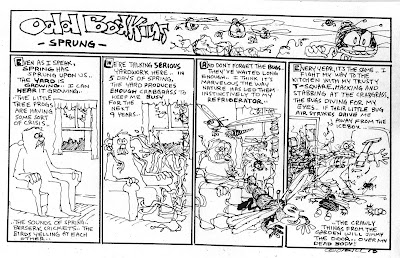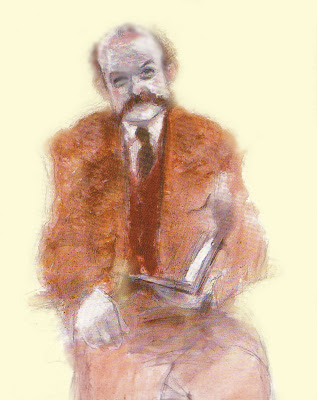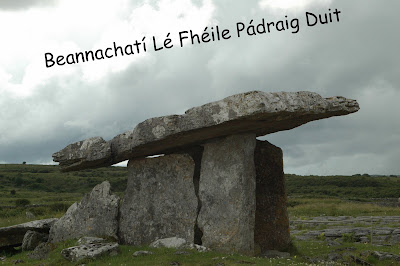Milo O'Shea and Dr. Art Hughes
Reception at Irish Arts Centre, New York

Reception at Irish Arts Centre, New York
Guest Blogger Dr. Art Hughes,
Fulbright Professor of Irish Language, NYU.
Fulbright Professor of Irish Language, NYU.
Dr. Art Hughes, MA, MèsL, PhD is Senior Fulbright Irish Language Scholar for 2009/10. He is a Visiting Professor at Glucksman Ireland House, New York University. He is Director of Irish Language Programmes at the University of Ulster in Belfast. His doctoral thesis was study of the Gaelic dialect of the Bluestack Mountains, Co. Donegal. he is a prominent scholar in the field of Celtic linguistics and literature. He has written and/or edited 15 books (in English, Irish, French and Breton). He is also the Chair of The McCracken Cultural Society and founder of Ben Madigan Press. Recent publications include The Great Irish Verb Book and The Big Drum a translation of Seosamh Mac Grianna's novel An Druma Mór – he is currently preparing a film script for the same. He also has recently collaborated on an anthology of Irish poet Nuala Ni Dhomhnaill in Irish and French.
Milo O’Shea gives a fine ‘Hebrew Lesson’ at The Irish Arts’ Centre
Who would believe it, a Hebrew lesson in an Irish theatre? But it is true, for on Thursday 23rd March at the Irish Arts Centre in New York City, a special function was held to honour veteran and renowned star of stage and screen, Irish actor Milo O’Shea, on occasion of his 80th birthday. Thespian O’Shea, a household name in Ireland, rose to prominence as a boy actor in Dublin and went on to play many roles on the Irish stage and screen during his long and distinguished career.
On the night I was able to share with our honourand, my fond early childhood memory of my late mother gathering us, as children, around her on the sofa in 1960s Belfast to watch Milo in Hugh Leonard’s television series Me Mammy. In addition to his nationwide fame in Ireland, Mr O’Shea has graced many stages in the West End of London and Broadway. Harold Pinter penned Night School for Milo on British television and his American television stints have included shows such as QB VII, Silent Song (Italia Award) and Peter Lundy and the Medicine Hat. Throughout his many years as an actor, Mr O’Shea has been nominated twice for Tony Awards – firstly for his performance in Staircase alongside Eli Walach, and, secondly, for his part in Mass Appeal (which, incidentally, landed him a Drama League Award and the Outer Critics’ Circle Award).
Back, however, to The Hebrew Lesson which was a short 30 minute film produced in 1972 by Wolf Mankowitz, a dramatist, journalist, novelist and screenwriter. Son of a Russian-Jewish bookseller in East London, it is hardly surprising that Mankowitz should concern himself with Hebrew in this work (which he originally wrote as a play). What is of immense interest to an Irish audience is that the film is based in Cork in the 1920s at the time of the Irish War of Independence. A young IRA man, being pursued by the English Black and Tans, stumbles into an attic which has been converted into a synagogue. As if this is not bizarre enough, the young man interrupts the senior Jewish resident during the latter’s self-taught Irish lessons as he was involved in selling his wares in the Gaeltacht area of rural West Cork.
It has to be said that the Mankowitz’s screenplay was nothing short of magnificent although we are happy to report that Mr O’Shea’s did justice to this finely-crafted screenplay with what was a virtuoso performance. This film, hardly surprisingly, won an award at The Cork Film Festival although it has sadly been neglected ever since then. This screening was a coup for the Irish Arts Centre, and we are deeply indebted to Georganne Heller (a theatre producer, board member and stalwart at the Irish Arts Centre) who uncovered the film in an archive during a recent visit to London. The Hebrew Lesson deserves a wider airing – and probably some subtitles, as there are lines in Irish and Hebrew at various junctures in the script.
The film, and the work of Milo O’Shea, were warmly introduced on the night by Mr Niall Burgess, the Irish Consul for New York. After the screening – and, of course, a richly deserved standing ovation - Mr O’Shea addressed the audience in a memorable and moving speech. Congratulations, Milo on a long and illustrious innings and many happy returns.








